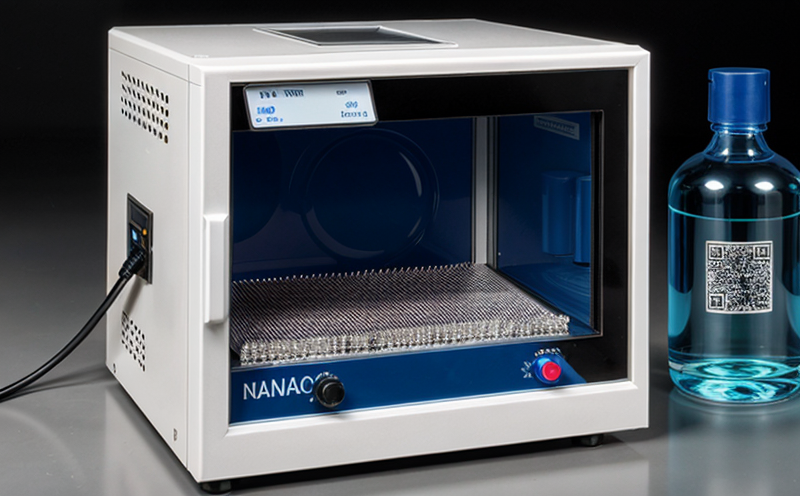GB T 37553 Surface Area Testing of Nanomaterials
The GB/T 37553-2019 Standard for Determination of Specific Surface Area and Pore Size Distribution of Nano-materials by Brunauer–Emmett–Teller (BET) Method is a critical tool in the chemical testing sector, particularly for nanomaterials. Nanomaterials have unique properties due to their small size, which makes accurate measurement of surface area and pore size distribution crucial.
This standard provides a comprehensive framework for the determination of specific surface area and pore size distribution using the BET method. The BET theory is based on the adsorption of gas molecules (typically nitrogen) at temperatures close to 77 K onto solid surfaces, where these molecules form monolayers. This allows for precise measurement of the surface area.
The standard specifies detailed procedures for sample preparation and analysis, ensuring accurate results in a repeatable manner. It is essential that samples are prepared according to the guidelines provided in this standard to ensure that the results are reliable and consistent with international norms.
The primary advantage of using GB/T 37553 is its ability to provide precise measurements for nanomaterials, which have surface areas significantly higher than those of conventional materials. This makes it indispensable for industries relying heavily on nanochemistry such as pharmaceuticals, electronics, and advanced coatings.
Another significant benefit is the standard's applicability across various types of nanomaterials including carbon nanotubes, metal oxides, and other complex structures. By providing a standardized approach, this method ensures that all participants in the chemical testing community are working to the same criteria, enhancing comparability and trustworthiness of results.
Understanding these nuances is crucial for industries where precision matters, as even small errors can lead to substantial discrepancies in product performance or regulatory compliance issues. The BET method used here aligns with international standards like ISO 9276-1:2015, which further validates its reliability and accuracy.
For quality managers and R&D engineers involved in the development and production of nanomaterials, adhering to this standard ensures that their products meet stringent industry benchmarks. Compliance officers also benefit from knowing how these standards impact regulatory requirements, ensuring smooth operations without delays due to non-compliance issues.
In summary, GB/T 37553 plays a pivotal role in the chemical testing of nanomaterials by offering precise methods for determining surface area and pore size distribution. Its significance lies not only in its technical accuracy but also in fostering consistency and reliability within the broader scientific community.
| Sample Preparation | Analytical Procedure |
|---|---|
| Ensure homogeneity of sample | BET method using nitrogen adsorption at 77 K |
| Grind and sieve the material | Determine surface area through multilayer adsorption model |
| Cleanse thoroughly to remove contaminants | Analyze pore size distribution with precision |
Industry Applications
The application of GB/T 37553 extends across multiple industries, each leveraging the standard in unique ways:
- Pharmaceutical Industry: Ensuring drug delivery systems operate efficiently by optimizing particle size and surface area.
- Electronics Sector: Developing advanced materials for semiconductors and batteries where high surface areas enhance performance.
- Environmental Science: Studying the behavior of nano-pollutants in aquatic environments to mitigate risks effectively.
The versatility of this standard allows it to be applied wherever nanomaterials are involved, making it an essential component for any laboratory specializing in chemical testing or materials science research.
By adhering strictly to the procedures outlined in GB/T 37553, researchers and manufacturers can ensure that their work aligns with global standards, thereby enhancing credibility and facilitating international collaboration. This standard supports innovation while maintaining safety and efficacy across various applications.
Environmental and Sustainability Contributions
The use of GB/T 37553 contributes positively to environmental sustainability by promoting the responsible handling of nanomaterials. Accurate measurement helps in understanding the impact these materials have on ecosystems, enabling informed decision-making regarding their safe disposal or recycling.
- Reduction of Waste: By optimizing the use of raw materials through precise surface area measurements, less waste is generated during production processes.
- Emission Control: Understanding the specific surface areas involved aids in controlling emissions from nanochemical processes, reducing overall environmental footprint.
Through such measures, laboratories adhering to GB/T 37553 not only contribute to better product quality but also play a role in sustainable practices. This aligns with broader goals set by international organizations like the United Nations Environment Programme (UNEP) and the European Union's Green Deal.
Use Cases and Application Examples
The application of GB/T 37553 is vast, encompassing numerous use cases across different sectors:
- Battery Technology: Ensuring optimal performance by optimizing electrode materials.
- Catalysis: Designing catalysts with enhanced activity through controlled pore size distribution.
| Use Case | Description |
|---|---|
| Battery Technology | Optimizing electrode materials for improved energy density and conductivity. |
| Catalysis | Enhancing catalyst efficiency through precise control of pore size distribution. |
| Semiconductors | Improving device performance by fine-tuning the surface area-to-volume ratio. |
| Pollution Control | Developing filters with high adsorption capacity for efficient pollutant removal. |
These examples illustrate how GB/T 37553 supports critical processes in various industries, driving advancements that benefit society and the environment alike. By adhering to this standard, laboratories ensure they are contributing positively to both technological progress and environmental sustainability goals.





